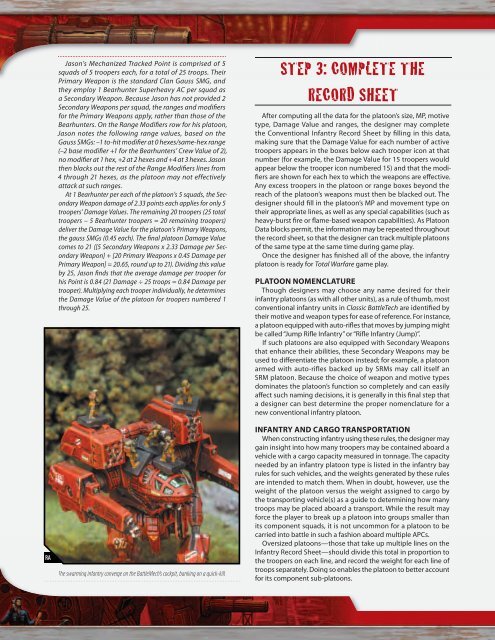the shape of things to come
the shape of things to come
the shape of things to come
You also want an ePaper? Increase the reach of your titles
YUMPU automatically turns print PDFs into web optimized ePapers that Google loves.
Jason’s Mechanized Tracked Point is comprised <strong>of</strong> 5<br />
squads <strong>of</strong> 5 troopers each, for a <strong>to</strong>tal <strong>of</strong> 25 troops. Their<br />
Primary Weapon is <strong>the</strong> standard Clan Gauss SMG, and<br />
<strong>the</strong>y employ 1 Bearhunter Superheavy AC per squad as<br />
a Secondary Weapon. Because Jason has not provided 2<br />
Secondary Weapons per squad, <strong>the</strong> ranges and modifi ers<br />
for <strong>the</strong> Primary Weapons apply, ra<strong>the</strong>r than those <strong>of</strong> <strong>the</strong><br />
Bearhunters. On <strong>the</strong> Range Modifi ers row for his pla<strong>to</strong>on,<br />
Jason notes <strong>the</strong> following range values, based on <strong>the</strong><br />
Gauss SMGs: –1 <strong>to</strong>-hit modifi er at 0 hexes/same-hex range<br />
(–2 base modifi er +1 for <strong>the</strong> Bearhunters’ Crew Value <strong>of</strong> 2),<br />
no modifi er at 1 hex, +2 at 2 hexes and +4 at 3 hexes. Jason<br />
<strong>the</strong>n blacks out <strong>the</strong> rest <strong>of</strong> <strong>the</strong> Range Modifi ers lines from<br />
4 through 21 hexes, as <strong>the</strong> pla<strong>to</strong>on may not effectively<br />
attack at such ranges.<br />
At 1 Bearhunter per each <strong>of</strong> <strong>the</strong> pla<strong>to</strong>on’s 5 squads, <strong>the</strong> Secondary<br />
Weapon damage <strong>of</strong> 2.33 points each applies for only 5<br />
troopers’ Damage Values. The remaining 20 troopers (25 <strong>to</strong>tal<br />
troopers – 5 Bearhunter troopers = 20 remaining troopers)<br />
deliver <strong>the</strong> Damage Value for <strong>the</strong> pla<strong>to</strong>on’s Primary Weapons,<br />
<strong>the</strong> gauss SMGs (0.45 each). The fi nal pla<strong>to</strong>on Damage Value<br />
<strong>come</strong>s <strong>to</strong> 21 ([5 Secondary Weapons x 2.33 Damage per Secondary<br />
Weapon] + [20 Primary Weapons x 0.45 Damage per<br />
Primary Weapon] = 20.65, round up <strong>to</strong> 21). Dividing this value<br />
by 25, Jason fi nds that <strong>the</strong> average damage per trooper for<br />
his Point is 0.84 (21 Damage ÷ 25 troops = 0.84 Damage per<br />
trooper). Multiplying each trooper individually, he determines<br />
<strong>the</strong> Damage Value <strong>of</strong> <strong>the</strong> pla<strong>to</strong>on for troopers numbered 1<br />
through 25.<br />
RA RA<br />
The swarming infantry converge on <strong>the</strong> BattleMech’s cockpit, banking on a quick-kill.<br />
STEP 3: COMPLETE THE<br />
RECORD SHEET<br />
After computing all <strong>the</strong> data for <strong>the</strong> pla<strong>to</strong>on’s size, MP, motive<br />
type, Damage Value and ranges, <strong>the</strong> designer may complete<br />
<strong>the</strong> Conventional Infantry Record Sheet by fi lling in this data,<br />
making sure that <strong>the</strong> Damage Value for each number <strong>of</strong> active<br />
troopers appears in <strong>the</strong> boxes below each trooper icon at that<br />
number (for example, <strong>the</strong> Damage Value for 15 troopers would<br />
appear below <strong>the</strong> trooper icon numbered 15) and that <strong>the</strong> modifi<br />
ers are shown for each hex <strong>to</strong> which <strong>the</strong> weapons are eff ective.<br />
Any excess troopers in <strong>the</strong> pla<strong>to</strong>on or range boxes beyond <strong>the</strong><br />
reach <strong>of</strong> <strong>the</strong> pla<strong>to</strong>on’s weapons must <strong>the</strong>n be blacked out. The<br />
designer should fi ll in <strong>the</strong> pla<strong>to</strong>on’s MP and movement type on<br />
<strong>the</strong>ir appropriate lines, as well as any special capabilities (such as<br />
heavy-burst fi re or fl ame-based weapon capabilities). As Pla<strong>to</strong>on<br />
Data blocks permit, <strong>the</strong> information may be repeated throughout<br />
<strong>the</strong> record sheet, so that <strong>the</strong> designer can track multiple pla<strong>to</strong>ons<br />
<strong>of</strong> <strong>the</strong> same type at <strong>the</strong> same time during game play.<br />
Once <strong>the</strong> designer has fi nished all <strong>of</strong> <strong>the</strong> above, <strong>the</strong> infantry<br />
pla<strong>to</strong>on is ready for Total Warfare game play.<br />
PLATOON NOMENCLATURE<br />
Though designers may choose any name desired for <strong>the</strong>ir<br />
infantry pla<strong>to</strong>ons (as with all o<strong>the</strong>r units), as a rule <strong>of</strong> thumb, most<br />
conventional infantry units in Classic BattleTech are identifi ed by<br />
<strong>the</strong>ir motive and weapon types for ease <strong>of</strong> reference. For instance,<br />
a pla<strong>to</strong>on equipped with au<strong>to</strong>-rifl es that moves by jumping might<br />
be called “Jump Rifl e Infantry” or “Rifl e Infantry (Jump)”.<br />
If such pla<strong>to</strong>ons are also equipped with Secondary Weapons<br />
that enhance <strong>the</strong>ir abilities, <strong>the</strong>se Secondary Weapons may be<br />
used <strong>to</strong> diff erentiate <strong>the</strong> pla<strong>to</strong>on instead; for example, a pla<strong>to</strong>on<br />
armed with au<strong>to</strong>-rifles backed up by SRMs may call itself an<br />
SRM pla<strong>to</strong>on. Because <strong>the</strong> choice <strong>of</strong> weapon and motive types<br />
dominates <strong>the</strong> pla<strong>to</strong>on’s function so completely and can easily<br />
aff ect such naming decisions, it is generally in this fi nal step that<br />
a designer can best determine <strong>the</strong> proper nomenclature for a<br />
new conventional infantry pla<strong>to</strong>on.<br />
INFANTRY AND CARGO TRANSPORTATION<br />
When constructing infantry using <strong>the</strong>se rules, <strong>the</strong> designer may<br />
gain insight in<strong>to</strong> how many troopers may be contained aboard a<br />
vehicle with a cargo capacity measured in <strong>to</strong>nnage. The capacity<br />
needed by an infantry pla<strong>to</strong>on type is listed in <strong>the</strong> infantry bay<br />
rules for such vehicles, and <strong>the</strong> weights generated by <strong>the</strong>se rules<br />
are intended <strong>to</strong> match <strong>the</strong>m. When in doubt, however, use <strong>the</strong><br />
weight <strong>of</strong> <strong>the</strong> pla<strong>to</strong>on versus <strong>the</strong> weight assigned <strong>to</strong> cargo by<br />
<strong>the</strong> transporting vehicle(s) as a guide <strong>to</strong> determining how many<br />
troops may be placed aboard a transport. While <strong>the</strong> result may<br />
force <strong>the</strong> player <strong>to</strong> break up a pla<strong>to</strong>on in<strong>to</strong> groups smaller than<br />
its component squads, it is not uncommon for a pla<strong>to</strong>on <strong>to</strong> be<br />
carried in<strong>to</strong> battle in such a fashion aboard multiple APCs.<br />
Oversized pla<strong>to</strong>ons—those that take up multiple lines on <strong>the</strong><br />
Infantry Record Sheet—should divide this <strong>to</strong>tal in proportion <strong>to</strong><br />
<strong>the</strong> troopers on each line, and record <strong>the</strong> weight for each line <strong>of</strong><br />
troops separately. Doing so enables <strong>the</strong> pla<strong>to</strong>on <strong>to</strong> better account<br />
for its component sub-pla<strong>to</strong>ons.


